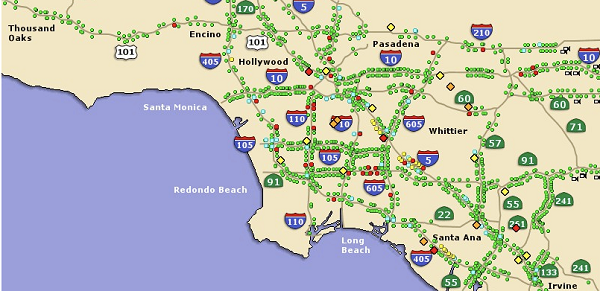It has happened to every Southern California (SoCal) driver at one time or another. You wake up in the morning or get off from a long day at work. All you can think about is getting where you need to go. Perhaps you are even running a bit behind schedule.
Then, the worst possible thing occurs. There is a Sig Alert on the route you are taking! Too late now. You could be stuck for hours in some of the worst traffic in the nation.
Read on to find out how you can avoid this unfortunate fate by learning just what a Sig Alert is and how you can plan your route around one.
What is a Sig Alert?
Sig Alerts are traffic warnings that the authorities issue when they expect a major backup on the roads. They declare a Sig Alert situation when an incident causes two lanes or more to be unavailable for at least two hours.
Despite most SoCal freeways having multiple lanes, these debilitating Sig Alert incidents usually result in serious traffic jams. The first problem is the closed lanes. Vehicles must merge into other lanes, which stalls the flow of traffic. Second is rubbernecking. People always slow down to stare at an accident. The cumulative effect of just a few seconds of staring results in even further congestion.
History of the Sig Alert
The Sig Alert originated in the 1940s. Traffic was becoming worse as more Southern Californians began purchasing cars. Jobs in the burgeoning defense industry had put money into the pockets of many who before did not have disposable income.
Local police would notify Loyd Sigmon, a popular Los Angeles radio reporter, of bad accidents. He would then inform the public on his show. Eventually, the broadcasts became widely known as “Sig-Alerts.” The police then began sending the alerts via electronic devices to Sigmon and other journalists.
Today, the California Highway Patrol (CHP) issues these warnings to both the media and public via a vast array of communication networks.
How to Avoid Traffic Congestion
Always check for ongoing Sig Alerts before leaving your home or workplace. Furthermore, keep checking while on the road. Quite often, you can make a hasty detour before getting into the proximity of a Sig Alert zone.
Where to Get Information
You are very fortunate that in this age of fast communication, the authorities have many ways to broadcast Sig Alerts. In the past, motorists had to be listening to the Loyd Sigmon Show to know what was going on.
These days, to find out about alerts, you can watch the television news. All SoCal news shows have routine traffic reports during the morning and afternoon rush hours. These stations also have websites that update as road conditions change.
The California Highway Patrol posts Sig Alerts on its website as well. If you are driving, look for warnings on the electronic message boards above the highways.
Also, local radio stations still announce Sig Alerts to keep listening to audiences informed.
Last, but certainly not least, you can download a Sig Alert notification program for your mobile device.
Avoid an Accident
The only thing worse than being trapped on a highway in Sig Alert-related traffic is being the source of the alert itself.
You can lessen your chances of causing an accident by attending traffic school. Be sure that the course is recognized by the state. You may even be able to receive a dismissal of any outstanding traffic tickets.

 Live Chat
Live Chat






